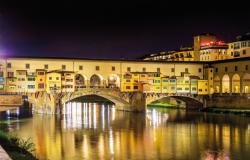Tucked away on the Via Ghibellina near Santa Croce in Florence is the Casa Buonarroti. Michelangelo (1475-1564, whose surname was Buonarroti) lived briefly in this group of three houses, which he bought as an investment in 1508.
Subsequent generations of his descendants added what they could to a collection of his works and today the Casa houses some intriguing jewels picked from the artist’s oeuvre.
The more narrow and creaky interiors of the Casa usher the visitor before the real curios, such as the wood model of the façade (never used) created by Michelangelo for the Medici church of San Lorenzo.
Even more fascinating are the early works, carved while Michelangelo was still in his teens, including his first piece the Madonna of the Stairs (a rectangular relief carved around 1490-92) and the Battle of the Centaurs of circa 1492.
It is the latter relief that, for me at least, provides the Casa’s most exhilarating look into the developmental stages of Michelangelo’s unique and compelling artistic vision.
Rooted in Mythology
 As its name implies, the Battle of the Centaurs relief is generally thought to illustrate the famous scene from Greek mythology.
As its name implies, the Battle of the Centaurs relief is generally thought to illustrate the famous scene from Greek mythology.
When the Lapith king Ixion died, his son Peirithous inherited his kingdom. Ixion’s other son Centaurus, estranged from his family since his copulation with wild Magnesian mares (to say nothing of his resulting race of savage part-human, part-horse creatures known as the Centaurs), was outraged and demanded a share in the rule.
In order to appease his brother, Peirithous invited the Centaurs to his wedding. As the wine began to flow the Centaurs gorged themselves, becoming outlandish and increasingly amorous.
They attempted to make off with the Lapith women (not even the bride was safe) and a bloody skirmish ensued, which the Lapiths eventually won. This battle was a favourite subject in ancient art, effectively and dramatically illustrating the virtue of civilisation over the damning forces of barbarism and bestiality.
It has been suggested that Michelangelo derived his knowledge of the scene from the Florentine poet Poliziano, who may have read the corresponding literary passages to the young sculptor.
The relief is instantly striking in its consistent evocation of an ideal and classical naked male beauty that may have owed something to the ancient sculpture that Michelangelo was able to see in Lorenzo de Medici’s garden in Florence.
The series of nude vistas addresses the viewer in a concise bodily language that signals the young Michelangelo’s burgeoning anatomical observation and interest (so much so that the relief appears to show almost exclusively human protagonists). The male nude form would go on to become Michelangelo’s most evocative and moving unit of expression.
Hints of Genius
 Despite Michelangelo’s apparent awareness of some sort of classical precedent when working on the relief, the Battle of the Centaurs is not an excuse for a sophisticated formal exercise.
Despite Michelangelo’s apparent awareness of some sort of classical precedent when working on the relief, the Battle of the Centaurs is not an excuse for a sophisticated formal exercise.
Nor does it constitute the artist’s nostalgic evocation of some forgotten past. Rather, Michelangelo’s real achievement here is to have created a fresh chaos of cyclonic proportions that reflects the frantic mood of the narrative.
What is more, as the eye begins to unpick the logic of the interlacing movements of the figures, one soon realises that for all the seeming confusion, there is absolutely nothing redundant or repeated in the scene.
Every character is conceived individually, his personal action thought through, revealing the already impressive figural and narrative control of the adolescent artist.
There are those that believe that the Battle of the Centaurs was left deliberately unfinished at the time of Lorenzo de’ Medici’s death in 1492, with the relief consciously reviving the tenet of Pliny’s writing that celebrates any unfinished work as an elucidation of the artist’s working process.
It is my opinion, however, that the different levels of relief in the carving – from the gleaming polish of the human flesh to the more roughly hatched patches of stone – are maintained as integral to the sense of the narrative that Michelangelo wanted to convey.
The story of his battle remains bound to the stone, so that the juxtaposition of surfaces embodies not only the struggle between divinity and bestiality, but also the sculptor’s personal relationship with the different facets of his material.
One of the most conceptually exciting passages of the relief is created in the two Lapith figures who stand to the left, both gripping boulders of rough stone, the very material from which the artist has evolved their humanity.
By maintaining a real sense of the block in some areas and energetically eliminating it in others, Michelangelo questions what it is that frames his scene. My answer is that it is man’s strength and dedication to a task that sets the boundaries for achievement, so that the higher levels of relief denote victory for the Lapiths as well as the personal triumph of the artist.
Museum Information
Casa Buonarotti,
Via Ghibellina 70,
50122 Florence
Tel (055) 24 17 52
www.casabuonarroti.it
Open 9:30 am–1:30 pm Wed-Mon
Closed 1 Jan, Easter Sun, 25 Apr, 1 May, 15 Aug, 25 Dec
There is an admission charge





